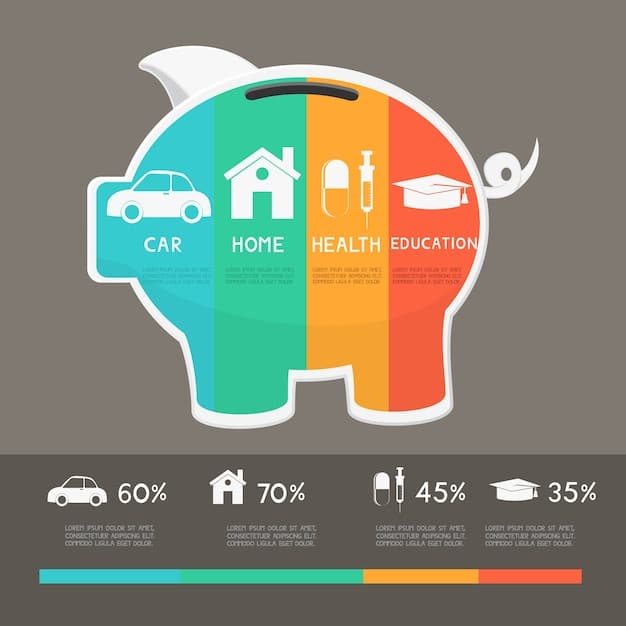HSA Savings Program Alert: What’s New for 2025?

Savings Program Alert: New Rules for Health Savings Accounts (HSAs) in 2025 are poised to offer enhanced flexibility and contribution limits, empowering individuals in the US to better manage their healthcare savings and plan for future medical expenses, aligning with evolving healthcare needs.
Are you ready to optimize your healthcare savings? The landscape of Health Savings Accounts (HSAs) is set to evolve significantly in 2025. Understanding these changes is crucial for maximizing your benefits and planning for future medical expenses. This article will delve into the key updates, providing you with a comprehensive overview of the Savings Program Alert: New Rules for Health Savings Accounts (HSAs) in 2025 and how they may impact your financial planning.
Understanding the Basics of Health Savings Accounts (HSAs)
Before diving into the new rules for 2025, let’s recap what Health Savings Accounts (HSAs) are and why they’re a valuable savings tool. HSAs are tax-advantaged savings accounts that can be used in conjunction with a high-deductible health insurance plan.
Here are some key aspects of HSAs:
Eligibility for an HSA
To be eligible for an HSA, you must be enrolled in a high-deductible health plan (HDHP). An HDHP typically has a higher annual deductible than traditional health insurance plans. You also cannot be covered by any other health insurance that is not an HDHP. Furthermore, you can’t be enrolled in Medicare, and you can’t be claimed as a dependent on someone else’s tax return.
Tax Advantages of HSAs
One of the biggest draws of HSAs is their tax advantages. Contributions to an HSA are tax-deductible, meaning they reduce your taxable income. The money in the HSA grows tax-free, and withdrawals for qualified medical expenses are also tax-free. This triple tax advantage makes HSAs a powerful tool for individuals looking to save for healthcare costs.
Benefits of HSAs
- Tax Savings: As mentioned, HSAs offer significant tax savings.
- Portability: HSAs are portable, meaning you can take them with you if you change jobs or health plans.
- Investment Opportunities: HSAs often allow you to invest your savings, potentially growing your money over time.
- Flexibility: You can use the money in your HSA for a wide range of qualified medical expenses, including deductibles, co-pays, and prescriptions.
In conclusion, understanding the basic framework of HSAs—their eligibility requirements, tax benefits, and overall advantages—is essential. This knowledge forms the foundation for appreciating the upcoming changes in 2025 and how they can further enhance the value of these accounts for healthcare savings.
Key Changes to HSA Contribution Limits in 2025
One of the most anticipated changes coming to Health Savings Accounts in 2025 is the adjustment to contribution limits. These limits are typically adjusted annually to account for inflation, but the projected increases for 2025 are expected to be significant.
Understanding these adjustments is key to maximizing your HSA benefits.
Projected Contribution Limit Increases
While the official contribution limits for 2025 have yet to be announced, experts predict substantial increases based on current inflation trends. This means individuals and families will have the opportunity to save even more in their HSAs, further leveraging the tax advantages these accounts offer. Staying informed about these projections and confirmed figures is crucial for effective financial planning.
Impact on Individual and Family Savings
The increase in contribution limits will directly impact how much individuals and families can save annually in their HSAs. For individuals, a higher contribution limit means they can allocate more pre-tax income to healthcare savings, reducing their overall tax burden. Families, who typically face higher healthcare costs, will also benefit from the increased limits, allowing them to save more to cover potential medical expenses.
Strategies for Maximizing Contributions
- Budget Planning: Plan your annual budget to accommodate the new contribution limits.
- Payroll Deductions: Utilize payroll deductions to automatically contribute to your HSA each pay period.
- Catch-Up Contributions: If you’re age 55 or older, take advantage of catch-up contributions to further boost your savings.
Ultimately, the upcoming changes to HSA contribution limits in 2025 present significant opportunities for individuals and families to bolster their healthcare savings. By staying informed about these changes, adjusting their financial strategies, and maximizing contributions, they can reap the full benefits of HSAs and secure their financial well-being in the face of rising healthcare costs.

Expanded Uses for HSA Funds Under the New Rules
Beyond contribution limits, the updated rules for Health Savings Accounts in 2025 may also expand the ways in which HSA funds can be used. These potential changes could make HSAs even more appealing and versatile for healthcare savings.
Understanding these expanded uses is vital for optimizing your HSA strategy.
Potential for Over-the-Counter Medications
One potential change involves allowing HSA funds to be used for over-the-counter (OTC) medications without a prescription. Currently, many OTC medications require a prescription to be eligible for HSA reimbursement. Relaxing this requirement would make it easier for individuals to use their HSA funds for common healthcare needs.
Coverage for Wellness Programs
Another potential expansion could include coverage for wellness programs, such as gym memberships or fitness classes. By incentivizing preventative care, this change could encourage individuals to prioritize their health and reduce their long-term healthcare costs. This shift could align HSA benefits more closely with overall wellness goals.
Impact on Healthcare Spending
- Increased Flexibility: Expanded uses for HSA funds would provide individuals with greater flexibility in how they spend their healthcare dollars.
- Greater Control: Individuals would have more control over their healthcare spending decisions.
- Potential Savings: By covering OTC medications and wellness programs, HSAs could help individuals save money on common healthcare needs and preventative care measures.
In essence, the potential for expanded uses of HSA funds under the new rules signals a move towards greater flexibility and empowerment for individuals in managing their healthcare expenses. By accommodating a wider range of healthcare needs and incentivizing preventative care, these changes could enhance the appeal and efficacy of HSAs as a valuable savings tool.
Impact of HSA Changes on Employer-Sponsored Health Plans
The upcoming changes to Health Savings Accounts in 2025 aren’t just relevant to individuals; they also have implications for employer-sponsored health plans that offer HSAs as part of their benefits package. Employers need to understand these changes to effectively communicate them to their employees and ensure their health plans remain competitive.
Here’s how the HSA changes might affect employer-sponsored plans:
Employer Contribution Strategies
With increased contribution limits, employers may need to revisit their contribution strategies to HSAs. Some employers offer matching contributions to encourage employee participation in HSAs. With higher limits, employers may need to adjust their matching formulas or contribution caps to remain competitive with other employers offering similar benefits.
Employee Education and Communication
Employers have a crucial role to play in educating their employees about the HSA changes in 2025. This involves providing clear and concise information about the updated contribution limits, expanded uses for HSA funds, and any other relevant changes. Effective communication can help employees make informed decisions about their healthcare savings.
Plan Design Considerations
- HDHP Compatibility: Ensure that the employer-sponsored health plan remains compatible with HSA requirements.
- Employee Enrollment: Develop strategies to increase employee enrollment in HSAs.
- Benefit Optimization: Optimize the overall benefits package to maximize the value of HSAs for employees.
In summary, the impact of HSA changes on employer-sponsored health plans underscores the importance of proactive planning and communication. By adjusting contribution strategies, educating employees, and carefully designing their health plans, employers can ensure that their employees are well-equipped to take advantage of the benefits offered by HSAs in the evolving healthcare landscape.
Strategies for Integrating HSAs into Retirement Planning
While Health Savings Accounts are primarily designed for healthcare savings, they can also play a significant role in retirement planning. Many individuals are discovering that HSAs can be a valuable tool for supplementing their retirement income and covering healthcare expenses in retirement.
Here’s how you can integrate HSAs into your retirement strategy:
Long-Term Growth Potential
One of the key advantages of HSAs is their long-term growth potential. The money in your HSA can grow tax-free over many years, making it a valuable asset for retirement. Unlike other retirement accounts, such as 401(k)s or IRAs, HSA funds can be withdrawn tax-free for qualified medical expenses at any time, including during retirement.
Using HSAs for Retirement Healthcare Costs
Healthcare costs are a major concern for many retirees. HSAs can help you cover these costs without having to withdraw from other retirement accounts. You can use your HSA funds to pay for Medicare premiums, long-term care insurance, and other qualified medical expenses during retirement. This can help you preserve your other retirement savings for non-medical expenses.
Maximizing Contributions Over Time
- Consistent Contributions: Make consistent contributions to your HSA throughout your working years.
- Catch-Up Contributions: Take advantage of catch-up contributions once you reach age 55.
- Investment Strategy: Develop a long-term investment strategy for your HSA funds.
In conclusion, integrating HSAs into retirement planning can be a savvy move for individuals looking to secure their financial future and safeguard against rising healthcare costs. By strategically leveraging HSAs for long-term growth and healthcare expense coverage, retirees can enhance their overall financial well-being during their golden years.

Navigating Potential Challenges and Risks with HSAs
While Health Savings Accounts offer numerous benefits, it’s important to be aware of potential challenges and risks associated with them. Understanding these challenges can help you make informed decisions about whether an HSA is right for you.
Here are some potential challenges and risks to consider:
Complexity of Regulations
HSA regulations can be complex and subject to change. It’s important to stay informed about the latest rules and regulations to ensure you remain compliant. Failure to comply with HSA regulations can result in penalties and loss of tax advantages.
Market Volatility
If you choose to invest your HSA funds, you’re exposed to market volatility. The value of your investments can fluctuate, and you could potentially lose money. It’s important to carefully consider your risk tolerance and investment strategy before investing your HSA funds.
Unexpected Healthcare Expenses
- Budgeting Challenges: Unexpected healthcare expenses can strain your budget and deplete your HSA savings.
- Limited Coverage: The HSA may not cover all of your healthcare expenses, especially if you have a high-deductible health plan.
- Penalties for Non-Qualified Expenses: Withdrawing HSA funds for non-qualified expenses can result in penalties and taxes.
In brief, while HSAs offer significant advantages, individuals should carefully weigh the potential challenges and risks before opting into this savings vehicle. By staying informed, managing market volatility, and preparing for unexpected healthcare expenses, individuals can mitigate these risks and maximize the benefits of HSAs.
| Key Point | Brief Description |
|---|---|
| 💰 Contribution Limits | Expected to increase in 2025, allowing more savings. |
| ⚕️ Expanded Uses | May include over-the-counter meds and wellness programs. |
| 💼 Employer Impact | Employers should educate employees and adjust strategies. |
| 👵 Retirement Planning | HSAs can supplement retirement income for healthcare. |
FAQ About HSA New Rules in 2025
▼
The primary anticipated changes include increased contribution limits, potentially expanded uses for HSA funds, and impacts on employer-sponsored health plans. These adjustments aim to enhance the value of HSAs for healthcare savings.
▼
Increased contribution limits allow you to save more annually in your HSA, reducing your taxable income and potentially growing your savings faster for future healthcare costs.
▼
The new rules may allow HSA funds to be used for over-the-counter medications without a prescription, providing greater flexibility in managing your healthcare expenses.
▼
Employers may need to adjust their contribution strategies and educate employees about the changes to maximize the benefits of HSAs in their health plans and stay competitive.
▼
Yes, HSAs can be integrated into retirement planning to cover healthcare costs, offering long-term growth potential and tax-free withdrawals for qualified medical expenses during retirement.
Conclusion
As we look ahead to 2025, the anticipated changes to Health Savings Accounts present both opportunities and considerations for individuals, families, and employers. Understanding these evolving rules and adapting your financial strategies accordingly will be key to maximizing the benefits of HSAs and securing your healthcare savings for the future.





